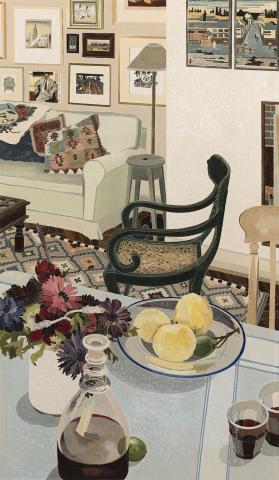INTERIOR WITH ANEMONES AND LEMONS, 1992
CRESSIDA CAMPBELL
unique colour woodblock print
89.0 x 52.0 cm
signed lower right: Cressida Campbell
Rex Irwin Art Dealer, Sydney (label attached verso)
The Estate of the late James O. Fairfax AC, Sydney, acquired from the above in 1992
Cressida Campbell, Rex Irwin Art Dealer, Sydney, 3 – 28 November 1992, cat. 7 (illus. on invitation)
Timeless: The art of Cressida Campbell, S. H. Ervin Gallery, Sydney, 10 January – 1 February 2009; and touring to Queensland University of Technology, Art Museum, Brisbane
McDonald, J., ‘The Woodblock Painting of Cressida Campbell’, Art and Australia, vol. 32, no. 4, Winter 1995, p. 507 (illus.)
Crayford, P., (ed.), The Woodblock Painting of Cressida Campbell, Public Pictures Pty Ltd, 2008, cat. P9207, p. 239 (illus.)
Cressida Campbell is an artist who requires no introduction, having attained, through years of fastidious and unwavering commitment, a level of undeniable public and critical recognition. Dedicated to a labour intensive and intricate medium, Campbell’s artistic output is notoriously slow-paced, resulting in high demand for her unique hand painted woodblock prints and woodblocks alike. This beautiful example of her serene domestic interiors, Interior with Anemones and Lemons, 1992, was purchased by the artist’s friend, the collector and philanthropist James O. Fairfax, from her representative gallery in Sydney, Rex Irwin Art Dealer and graced the walls of his beachside home throughout the last years of his life.
It is clear that Campbell is a pure aesthete. Her works are sublime, carrying no socio-political impetus, nor aiming to surprise or shock viewers. Taking cues from her immediate environment, from the lush bushlands around Sydney harbour to the patterns of shadows on her kitchen floor, Campbell delights in the form and colour of everyday objects, translating them into artworks that express with enduring appeal the quiet tranquillity of her visions.
Interior with Anemones and Lemons is a precise snapshot of a commonplace scene; in this case, an airy and sun-drenched corner of the living room of the artist’s Tamarama home, in which she lived until 2001. Resting on the Kilim rug, is a green chair that has just been vacated, the key element in The Green Chair, 1996 and a domestic feature seen since in a number of her compositions. Building on the comfort of an intimate and familiar subject, Campbell creates unique impressions through considered and often unconventional compositions, subtle and harmonious renditions of colour and texture. Presenting an aura of careful casualness, her scenes appear to have been stumbled upon, and are curiously devoid of actors. Their presence is otherwise indicated through poetic details – a half consumed glass of wine, a crumpled dishcloth or an open book. Fragments of artworks from the artist’s own collection and other bibelots populate these interiors, each chosen for their aesthetic value - lending insight into the shaping of her harmonious decorative style and providing motifs that are carried throughout her oeuvre. As John McDonald wrote, to qualify Campbell as a decorator is no insult, despite the word’s current pejorative connotations, as ‘she is a decorator in the same manner as Matisse or Bonnard … in bringing us back to simple things, Campbell is exploring a decorative art for our times … the vital difference is that her prints almost radiate with the pleasure of their own making’.1
Densely patterned with miniature still-lives, Campbell’s interiors are rich with modest fragments of quotidian delight: bunches of wilting cut flowers, the complex rattan weave of the seat of a chair, the gleam of the edge of a glass bowl or the iridescent colours reflected off the surface of a carafe of red wine. Memorialising these everyday details from her domestic environment and elevating them to the hallowed surfaces of her compositions, Campbell makes no comment on distinctions between fine art and decoration, simply addressing the things in which she derives an aesthetic pleasure and hoping that others will respond in turn to their seductive impact.
1. McDonald, J., ‘The Woodblock Painting of Cressida Campbell’, in Crayford, P. (ed.), The Woodblock Painting of Cressida Campbell, Public Pictures, Sydney, 2008, pp. 17 – 19
LUCIE REEVES-SMITH
